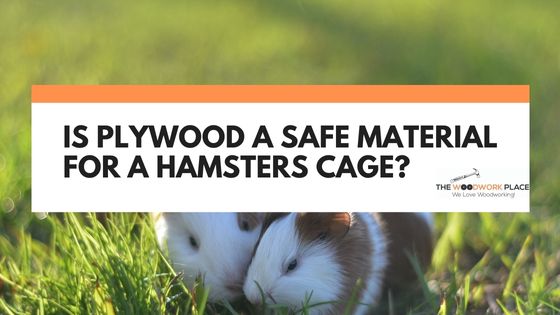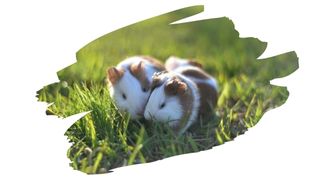If you’re a hamster owner, you want nothing but the best for your furry friend. So, you may be wondering, is plywood safe for hamsters? Well, you’ve come to the right place! In this article, we’ll dive into the world of hamster habitats and determine whether plywood is a suitable option. Let’s get started and find out if plywood is a safe choice for your little hamster buddy.
Hamsters are curious creatures and love to explore their environments. It’s important to provide them with a safe and secure habitat that meets their needs. One popular option for creating hamster cages or accessories is plywood. But before you rush off to build the ultimate hamster playground, let’s take a closer look at whether plywood is the right choice for our tiny friends.
When considering the safety of plywood for hamsters, there are a few factors to take into account. From the type of plywood used to any potential hazards, we’ll explore everything you need to know to make an informed decision. So, buckle up, pet lovers, and let’s navigate the world of plywood and its compatibility with our adorable hamster pals.
When it comes to hamsters, safety is crucial. Plywood can be safe for hamsters as long as it is untreated and does not contain any harmful chemicals. To ensure the plywood is safe, check for any signs of mold or damage before using it for your hamster’s habitat. Additionally, make sure the edges are smooth to prevent any injuries. Providing a plywood hideout or platform can add enrichment to your hamster’s environment.

Is Plywood Safe for Hamsters?
When it comes to caring for our furry friends, safety is always a top priority. In the case of hamsters, their small size and sensitive respiratory systems make it crucial to provide them with a safe and healthy environment. One common question that arises is whether plywood is safe for hamsters. In this article, we will explore the various aspects of using plywood in hamster enclosures and discuss its safety implications. We will also provide tips and alternatives to ensure the well-being of your hamster.
Why Plywood Is a Popular Choice
Plywood is a widely used material in various DIY projects, including building hamster enclosures. It consists of multiple layers of thin wood veneer glued together, making it durable and easy to work with. Plywood is popular among hamster owners due to its affordability, availability, and versatility in creating custom enclosures. However, before deciding to use plywood, it’s important to consider its safety aspects and potential risks.
The Safety of Plywood for Hamsters
While plywood is a commonly used material, caution must be taken when using it in hamster enclosures. Here are the key points to consider:
- Toxic Chemicals: Some types of plywood may contain chemicals and adhesives that could be harmful to hamsters if ingested or inhaled. It’s essential to choose plywood that is specifically labeled as safe for animals or use untreated plywood.
- Chewing Hazards: Hamsters are known for their chewing habit, and plywood may splinter or have rough edges that can pose a choking hazard or cause injury. Be sure to sand down any rough edges and regularly inspect the enclosure for signs of wear and tear.
- Hygiene: Plywood can absorb moisture, leading to mold or bacterial growth if not properly maintained. Regular cleaning and disinfecting of the enclosure are crucial to prevent these issues.
If you choose to use plywood in your hamster’s enclosure, here are some additional tips to ensure their safety:
- Opt for high-quality plywood that is specifically designed for pet enclosures.
- Ensure that the plywood is free from toxic chemicals, such as formaldehyde.
- Seal the plywood with a pet-safe sealant to prevent moisture absorption and make it easier to clean.
- Regularly inspect the enclosure for any signs of damage or wear and replace any compromised sections promptly.
Alternatives to Plywood
If you are uncertain about using plywood or prefer to explore alternative options, here are a few safe and suitable materials for constructing hamster enclosures:
1. Natural Wood:
Natural wood, such as untreated pine or aspen, can be a safe and aesthetically pleasing choice for hamster enclosures. Ensure that the wood is untreated and free from any coatings or chemicals that could be harmful to your hamster.
2. Acrylic:
Acrylic is a transparent material that is easy to clean and provides a great view of your hamster. It is also durable and does not splinter, making it a safe option. However, acrylic enclosures may be more expensive compared to plywood.
3. Wire Cages:
Wire cages are a popular choice for hamster owners as they provide proper ventilation and are easy to clean. It’s important to choose cages with bar spacing that is appropriate for the size of your hamster, ensuring that they cannot squeeze through or get stuck between the bars.
Conclusion
When it comes to providing a safe and comfortable habitat for your hamster, careful consideration is necessary. While plywood can be used in hamster enclosures, it’s important to prioritize safety and choose suitable materials. Whether you decide to use plywood or explore alternative options like natural wood, acrylic, or wire cages, the well-being of your hamster should always be the top priority. Regular inspection, maintenance, and hygiene practices will ensure a safe and happy home for your furry friend.
Key Takeaways: Is Plywood Safe for Hamsters?
- Plywood can be a safe option for hamsters as long as it is untreated and free from harmful chemicals.
- Avoid using plywood with rough surfaces, as it can cause injuries to your hamster’s delicate feet.
- Provide a layer of bedding or fabric on top of the plywood flooring to offer comfort and prevent slipping.
- Regularly inspect the plywood for any signs of damage or splintering, as these can harm your hamster.
- Ensure proper ventilation in the hamster enclosure to prevent the accumulation of moisture in the plywood, which can lead to mold or mildew.
Frequently Asked Questions
Welcome to our FAQ section where we address common concerns about the safety of using plywood for hamsters. If you’re a pet owner or considering getting a hamster, you may wonder if plywood is a suitable material for their enclosures. Read on to find answers that will put your mind at ease.
1. Can I use plywood to make a cage for my hamster?
Yes, plywood can be a safe and suitable material for constructing a hamster cage. It is important to ensure that the plywood is untreated, meaning it does not have any chemicals or finishes that could be harmful to your pet. Additionally, the plywood should not have any splinters or rough edges that could potentially injure your hamster. By choosing the right type of plywood and properly preparing it, you can create a secure and comfortable home for your furry friend.
However, it is crucial to note that plywood alone is not sufficient for a hamster cage. You will also need to provide proper ventilation, bedding, and other essential elements to ensure your hamster’s well-being.
2. What type of plywood should I use for a hamster cage?
When selecting plywood for your hamster’s cage, it is best to choose a hardwood plywood. Hardwood plywood is typically more durable and less likely to splinter than softwood plywood. Make sure to avoid plywood that is marked “treated” as it may contain chemicals that could be harmful to your pet. Opt for plywood that is specifically marketed as safe for pets or is labeled as untreated.
Additionally, it is important to select a plywood thickness that is sturdy enough to provide a secure enclosure for your hamster. Consult with professionals at your local hardware or pet store for the best plywood options available in your area.
3. How do I prepare plywood for a hamster cage?
Before using plywood for a hamster cage, it is essential to prepare the material properly. Start by sanding the edges and surfaces of the plywood to ensure there are no rough areas or splinters that could harm your hamster. Be thorough and pay attention to corners and joints to ensure a smooth finish.
Next, make sure to clean the plywood thoroughly with mild soap and water. This will help remove any dust or debris. Rinse it well and allow it to dry completely before using it to construct the cage. Taking these precautions will minimize the risk of harm to your hamster and create a safe environment for them to live in.
4. Are there any dangers associated with using plywood for hamsters?
While plywood can be safe for hamsters when prepared and used correctly, there are some potential risks to be aware of. One of the main concerns is the use of treated or finished plywood with chemicals that could be toxic to your pet. Always opt for untreated plywood to ensure the safety of your hamster.
Another risk is the presence of splinters or rough edges on the plywood. These can cause injuries or discomfort to your hamster. Taking the time to properly sand and prepare the plywood will help eliminate this risk. Regularly inspecting the cage for any signs of damage or wear will also help prevent any potential harm.
5. Can plywood be used for other hamster accessories?
Absolutely! Plywood can be used to create various accessories for your hamster, such as ramps, platforms, and hideouts. Be sure to follow the same guidelines as for constructing the cage itself. Use untreated plywood, prepare it properly, and ensure there are no rough edges or splinters that could harm your pet. By using plywood to design accessories, you can provide your hamster with a stimulating and enriching environment.
Remember to regularly check and clean these plywood accessories to maintain their safety and ensure they are in good condition for your hamster to enjoy.

SAFE & UNSAFE hamster beddings + alternatives!
Summary
So, is plywood safe for hamsters? Well, the answer is both yes and no. While plywood itself may not be harmful to hamsters, the glues and chemicals used in some types of plywood can be dangerous. It’s essential to choose plywood that is labeled as safe for animals and avoid those that contain formaldehyde or other toxic substances.
To ensure the safety of your hamster, it’s best to use alternatives like untreated solid wood or pet-safe plywood. Additionally, always thoroughly clean and air out any new materials before introducing them to your hamster’s habitat. Remember, the health and wellbeing of your furry friend should always be a top priority.
